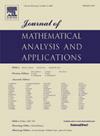在深度为1的实零点上的拟模形式
IF 1.2
3区 数学
Q1 MATHEMATICS
Journal of Mathematical Analysis and Applications
Pub Date : 2025-08-22
DOI:10.1016/j.jmaa.2025.129991
引用次数: 0
摘要
我们讨论了PSL2(Z)的模形式的临界点,或者更一般地说,深度为1的准模形式的零点。特别地,我们考虑唯一权值k模形式fk的导数,其傅立叶系数在常数1之后连续为零的最大值。我们的主要结果表明:(1)在标准基域上,爱森斯坦级数导数附近的深度为1的拟模形式的每一个零都位于测地线段{z∈H: μ d (z)=1/2}上,(2)对于k足够大且k≡0(mod12)时,标准基域上fk的超过四分之一的零位于测地线段{z∈H: μ d (z)=1/2}上。本文章由计算机程序翻译,如有差异,请以英文原文为准。
On the real zeros of depth 1 quasimodular forms
We discuss the critical points of modular forms, or more generally the zeros of quasimodular forms of depth 1 for . In particular, we consider the derivatives of the unique weight k modular forms with the maximal number of consecutive zero Fourier coefficients following the constant 1. Our main results state that (1) every zero of a depth 1 quasimodular form near the derivative of the Eisenstein series in the standard fundamental domain lies on the geodesic segment , and (2) more than quarter of zeros of in the standard fundamental domain lie on the geodesic segment for large enough k with .
求助全文
通过发布文献求助,成功后即可免费获取论文全文。
去求助
来源期刊
CiteScore
2.50
自引率
7.70%
发文量
790
审稿时长
6 months
期刊介绍:
The Journal of Mathematical Analysis and Applications presents papers that treat mathematical analysis and its numerous applications. The journal emphasizes articles devoted to the mathematical treatment of questions arising in physics, chemistry, biology, and engineering, particularly those that stress analytical aspects and novel problems and their solutions.
Papers are sought which employ one or more of the following areas of classical analysis:
• Analytic number theory
• Functional analysis and operator theory
• Real and harmonic analysis
• Complex analysis
• Numerical analysis
• Applied mathematics
• Partial differential equations
• Dynamical systems
• Control and Optimization
• Probability
• Mathematical biology
• Combinatorics
• Mathematical physics.

 求助内容:
求助内容: 应助结果提醒方式:
应助结果提醒方式:


